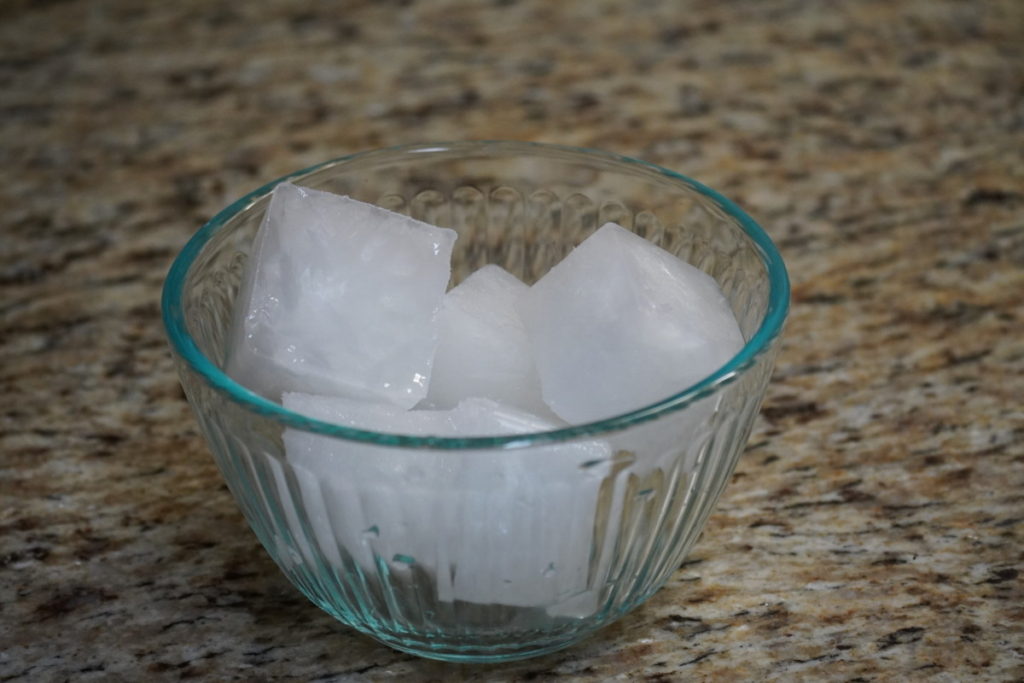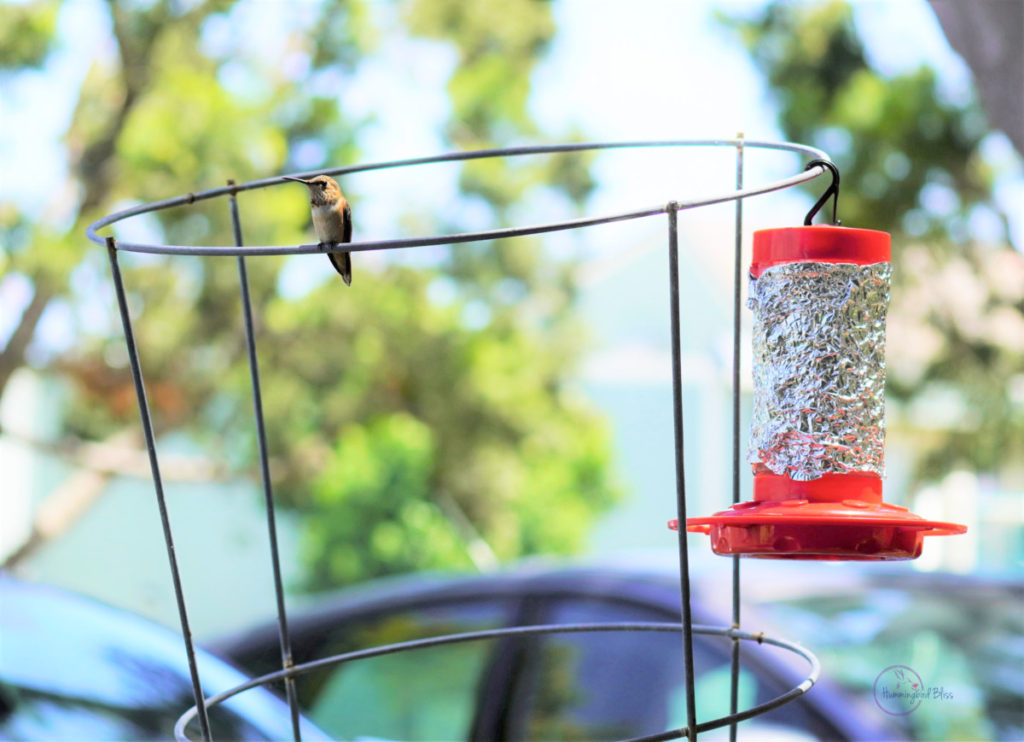This post contains affiliate links.
Keeping hummingbird nectar cool in the feeders during the summer heat can be extremely challenging. Hummingbird nectar degrades faster when continually exposed to direct sunlight or ambient temperatures above 90 degrees Fahrenheit. Discovering ways to provide hummingbirds with safe, cool and refreshing nectar is a complicated obstacle but one that has simple solutions.
How do you keep hummingbird nectar cool during the summer?
- Place feeders in the shade
- Purchase glass feeders
- Rotate nectar reserves
- Add frozen ice cubes to nectar
- Freeze nectar into ice cubes
- Use water misters around the feeder
- Wrap feeder in aluminum foil
- Apply an insulation sleeve to the feeder
The most important reason to keep hummingbird nectar cool is to prevent deadly bacterial and fungal growth.
Numerous hummingbird enthusiasts, while cleaning and disposing of old nectar during excruciating heat waves, are shocked at how hot the nectar becomes. Many express their experiences of feeling as if they have been burned with the hot nectar.
While hummingbirds tolerate hot nectar much like humans can drink and tolerate hot coffee, both would be happier on a hot summer’s day with a cooler drink. If the nectar is “too hot” for a human to touch, it is too hot for the hummingbird to drink.
For devoted hummingbird admirers yearning to help their friends get through the rough transitional summer period, these are my suggestions:
Place Feeders in the Shade
Our society has the comfort of manipulating the environment using various cooling mechanisms such as air conditioning, swimming in a temperature controlled pool, consuming cool beverages and tasty cold treats.
Hummingbirds do not have that luxury and are limited in their available cool and uncontaminated food source options depending on what the natural environment or the hummingbird enthusiast provides.
The most obvious recommendation on how to keep hummingbird nectar cool is to place the feeder in the shade. Whether hung from a tree in a natural canopy, under an eave of a house, or shaded by an umbrella, these suggestions are extremely important but are only half of the battle to keep the hummingbird nectar cool.
The nectar placed in the shade will not get hotter than the ambient temperature of its surroundings.
Since heat affects the quality of the sugar nectar, hummingbird nectar in the shade at an ambient temperature of 90 degrees Fahrenheit or above is just as harmful to the nectar as if it were placed in direct sunlight. The difference is the speed of deterioration, which affects the quality of the nectar. It is important for feeders to stay out of direct sunlight as much as possible.
When deciding on where to place a feeder, scout the surroundings and find a location that keeps the feeder in the most shade during the day. If there are any large trees, use the benefit of the tree canopy to keep the feeder nectar protected from direct morning and afternoon sunlight. Indirect light is wonderful.
Feeder placement is important. Placing feeders in the shade during high temperatures slows the fermentation process of the homemade nectar while allowing a resting place for the hummingbirds to shelter from direct sunlight.
If sun exposure is inevitable, place the feeder on the north or eastern side of the trees or structures, such as your house. The afternoon sun is blocked and will keep the nectar from increasing in temperature.
The ideal situation is to have a shaded location for both the hummingbird and their food source that they fiercely protect. Feeders in the shade help to maintain a healthy hydrated and well-nourished hummingbird.
See my article on: 10 Common Things That Kill Hummingbirds
Purchase Glass Feeders
Glass feeders are recommended in any location where ambient temperature regularly reaches 90 degrees Fahrenheit or greater. They provide a thicker barrier from outside atmospheric temperatures and minimizes the nectar from fermenting quickly during hot weather.
Glass is inert and does not react with chemicals. It provides a cleaner surface for the nectar. Glass is easier to clean, is scratch resistant and provides a pure environment minimizing the growth of bacteria and fungus. This can easily be spread from feeder to feeder causing distress for the hummingbirds.
In order to maintain healthy hummingbird friends, frequently clean and sanitize the feeders.
Glass feeders with a wide mouth or opening are easier to clean.
They may cost a little more, but are worth the price in the long run if you live in an area where the summers are brutally hot.
Rotate Nectar Reserves
When high temperatures are your nemesis, rotating the homemade nectar and providing a constant supply of cool hydration for your hummingbird friends is a priority for their health and well-being.
The following are “red flags” to keep in mind when deciding when to change the feeders and rotate them with clean unfermented nectar for your outdoor companions:
Is the feeder hot to touch? Do you see condensation inside of the feeder where there is no liquid? Is the sugar nectar cloudy? Is the sugar nectar thick and syrupy? Are there bees congregating around the feeder?
Accomplishing the task of rotating your feeders requires preparing larger reserves of homemade nectar using the basic recipe of 1 cup granulated white sugar dissolved in 4 cups of spring or filtered water. This sugar to water recipe closely resembles nectar naturally found in flowers.
Double or triple the recipe and keep it cool in the refrigerator until it is time to be used.
See my article: Forget Commercial Hummingbird Food Try Making Homemade Nectar
I prefer using glass jars such as quart sized Mason jars or cleaned and recycled quart sized mayonnaise jars. Quart portions are manageable compared to gallon quantities. If a solution becomes contaminated, disposing of a smaller amount is more cost effective.
By performing these tasks it will allow frequently cleaned hummingbird feeders to be refilled by cool refreshing reserves of nectar.
Another option, if your refrigerator has enough space to accommodate your feeders, is to keep the same number of feeders in the refrigerator as are hanging outside and simply swap them out repeatedly throughout the day as needed.
The average temperature in a refrigerator is 41 degrees Fahrenheit. It takes about 90 minutes to cool the nectar once the feeder is placed in the refrigerator.
And for the serious hummingbird enthusiast with many feeders, purchasing an inexpensive used refrigerator and keeping it in the garage may be the easiest technique of all for keeping hummingbird nectar cool during the summer.
Add Frozen Ice Cubes to Nectar
When rotating the nectar reserves becomes time consuming or you are on a time limit, a quick and easy temporary solution is to add plain water ice cubes to your homemade nectar.
If water ice cubes are going to be used, instead of making the recommended homemade nectar recipe of 1 cup of granulated white sugar dissolved in 4 cups in a Pyrex cup, make concentrated homemade nectar by using 1 cup granulated white sugar dissolved in 3 ½ to 3 3/4 cups of water.
Once the sugar is dissolved into the water, add the ice cubes to the 1 cup line and stir. After the water ice cubes melt, it will bring the sugar concentration levels back to the 1:4 ratio. This ensures the nectar will not become diluted and unsuitable for the hummingbirds.
Make sure to check and test the temperature of the nectar. Verify that the nectar is cooled down enough before refilling and hanging your feeders.
Freeze Nectar into Ice Cubes
Frozen sugar water freezes at a lower temperature of 27 degrees Fahrenheit. than regular water which freezes at 32 degrees Fahrenheit. This makes nectar ice cubes more effective than regular ice cubes.
Fill ice cube trays with homemade hummingbird nectar and put them in the freezer. Rotate the trays and repeat the process.
Experiment and determine what works the best for your situation. Two possibilities include:
- Fill the feeder with a combination of frozen nectar with homemade room temperature nectar.
- Fill the feeder with frozen nectar only.



In climates with harsher temperatures the high temperatures will easily thaw the frozen nectar.
As the frozen nectar cubes melt it will not dilute or change the concentration of the nectar.
Be aware that hummingbird nectar CAN be too cold for hummingbirds as well, causing what is called cold-stunned. Adding frozen nectar cubes should not bring the temperature of the nectar to a cold-stunned reaction.
Can drinking cold hummingbird nectar cause cold stun?
Hummingbirds drinking cold nectar will not cause cold stun with one exception.
Drinking hummingbird nectar at near 27 degrees Fahrenheit may cause cold stun if the ambient temperature is sub-freezing.
In a FAQ article from Audubon.org it states:
“In areas where the nighttime temperatures only dip slightly below freezing your hummingbird nectar may not freeze as the sugar solution has a lower freezing point than plain water. However, it’s better not to have your hummingbirds drink very cold nectar; this can actually cold-stun them”.
In this article they are talking about hummingbird feeders being left up in sub-freezing temperatures, so the actual nectar itself is down too near 27 degrees Fahrenheit.
Numerous articles claim that hummingbird nectar can be kept in the refrigerator for up to a week.
Some say refrigerated nectar can be served directly from the fridge, but others recommend “letting it warm up a little” before adding it to the hummingbird feeder.
The refrigerator temperature is usually set at 38 degrees Fahrenheit.
Many claim their hummingbirds seem to prefer the cooler nectar over the ambient temperature nectar.
How cold does hummingbird nectar get when adding frozen nectar cubes?
Calculation of hummingbird nectar temperature after adding ice cubes:
These calculations are based on ice cubes’ effect of cooling room temperature water.
I know that 1:4 hummingbird nectar freezes at 27 degrees Fahrenheit and water freezes at 32 degrees Fahrenheit.
The calculation below is for melting ice cubes in water, so there will be a differential of 5 degrees Fahrenheit when calculating the effects of melting frozen nectar cubes in hummingbird nectar at room temperature of 66.2 degrees Fahrenheit.
To completely melt the ice in a beverage-sized container of water will only drop the liquid starting temperature of 66.2 degrees Fahrenheit to a temperature of 51.8 degrees Fahrenheit.
Since I’m not a mathematician, I’m assuming that using hummingbird nectar and hummingbird nectar ice cubes will drop that lowest temperature to 46.8 degrees Fahrenheit.
These formulas come from the post by tec-science.
Then there is this article from ebird.org stating hummingbirds are seen in ambient temperatures of -9 degrees Fahrenheit with a wind-chill factor of -36 degrees Fahrenheit.
My conclusion is:
Hummingbird nectar at 27 degrees Fahrenheit may cause cold stun in hummingbirds during sub-freezing ambient temperatures, but nectar at 38 degrees right out of the refrigerator will not cause cold stun, and certainly, hummingbird nectar cooled to 46 degrees Fahrenheit most certainly will not cause cold stun.
Use Water Misters Around Feeder
A patio misting system helps decrease the ambient temperatures around the hummingbird feeders to keep them cool. The hummingbirds receive a cool food source along with extra droplets of water to help them regulate their core body temperature.
Hummingbirds typically receive an adequate amount of hydration through the nectar they consume, but extra water sources are always welcome to their daily routine.
There are pre-assembled and easy to use misting systems that take approximately 5 minutes to install. Make sure your misting system has access to a water source close by such as a water faucet or sprinkler.
If you have any concerns that the fine shower coming from the mister is still too strong or overwhelming for the hummingbirds, placing the mister farther away from the feeder will help soften the spray.
The positives of using a mister is to cool off the hummingbird feeder and the ambient temperature along with providing an extra bonus of refreshing mist for the hummingbirds.
The downside of using a mister in a humid climate is that evaporation is limited and can provide an easy environment for harboring bacteria and fungus in locations adjacent to feeders.
In a dryer climate the water will evaporate faster requiring increased misting to keep the feeder cool.
Misters can leave residual water marks or calcium deposits on windows depending on the mineral content of the local water supply. When positioning a mister, consider the mineral content of your municipal water supply and keep the mister from facing and spraying on windows.
If you are planning on utilizing one water source for the water hose as well as the mister, you will need to acquire a hose splitter which can be purchased at any retail home improvement store for less than $10.
A water feature in any space is an added bonus in the mind of a hummingbird.
Wrap Feeder in Aluminum Foil
Aluminum foil’s beneficial physical properties include reflectivity, adaptability, pliability and non-transparency.
Covering the nectar portion of a hummingbird feeder with aluminum foil reflects approximately 98% of thermal radiant heat and light as well as obstructing UV rays that come in contact with the feeder food.
I would suggest crumbling the aluminum into a ball and then opening it up before applying it to the feeder. The crinkling affect will add air pockets between the aluminum foil and the feeder thereby further insulating the nectar.

Defending a feeder with foil. Sitting on top of a tomato cage.

Taking his job very seriously!
The folklore of adding flashy objects to your surroundings to discourage birds from visiting or eating the fruit from the trees is apparently a myth. As you can see in my photograph, the hummingbirds are not affected by the aluminum.
Note: From experience, apply the aluminum to the top nectar portion of your feeder first before filling. This reduces the chances of spilling.
Apply an Insulation Sleeve around the Feeder
Adding an insulation sleeve to the glass or plastic nectar compartment of the feeder will keep the nectar cooler for an extended period of time.
Insulation sleeves are commonly used to keep beverages such as soda cans and bottles cool. Cut the bottom off the soda can insulator sleeve of your choice and make a slit down the side. This technique will make it easy to wrap the sleeve around the hummingbird feeder.
The outside color of the insulation sleeve will make a difference here as well. White would be the preferred choice because of its heat reflective properties. I recommend using a lighter color, however remember violets and yellows may attract bees.
See my article: Bees On My Hummingbird Feeder: (9 Tips To Get Rid of Them)
Conclusion
Just as hummingbirds require a shaded and covered location protected from direct sunlight during hot weather, so does their food supply.
Eating a meal in the shade from a glass feeder not only allows them to enjoy a hydrating nutritional break without overheating from the sweltering temperatures, but keeps their nectar source at the ambient temperature and decreases the speed of the fermentation process.
Other solutions to keep hummingbird nectar from not spoiling or overheating is to add frozen nectar or water ice cubes to your homemade solution, using a water mister to cool the surrounding temperatures near the feeders and wrapping aluminum foil around the feeder to reflect sunlight.
Utilizing more than one idea on how to keep your hummingbird nectar cool is to combine the frozen nectar with the use of an insulation sleeve then placing the feeder in a shaded location. This makes the frozen nectar cubes last longer, much like the insulated thermal containers humans use to keep their drinks cold.
Practice, conduct and determine in what order the recommended steps work in your neighborhood.
For more in depth information see my article on: How to Help Hummingbirds in Hot Weather
Happy Hummingbird Watching!

Backyard Visitors participates in affiliate programs which compensate us for referring traffic.


